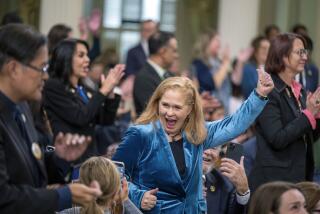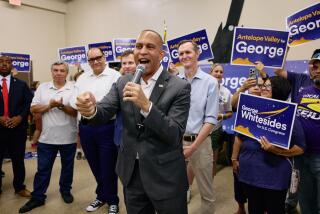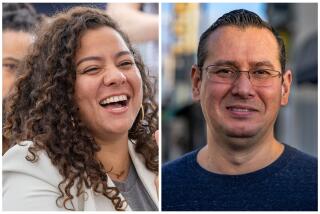A SNAPSHOT OF THE ASSEMBLY RACES
California’s 1992 elections feature the most open, competitive state Assembly races in decades. The reason? Two political upheavals that have shaken politics across the state: the redrawing of legislative district lines and the threat of term limitations imposed by Proposition 140.
HERE ARE THE KEY FACTORS:
1. Out of 80 incumbents, 28--or 35% of the Assembly--are leaving office to retire, run for other offices or to run in newly drawn Assembly districts, some as designated incumbents.
2. A record 332 candidates are seeking Assembly seats--142 Democrats and 190 Republicans. Many of those candidates are running in 25 new Assembly districts that have no incumbents.
3. Several incumbents in both parties are facing tough primary battles.
4. New district boundaries drawn to give ethnic communities a better chance to elect representatives have attracted candidates who have not run for state office before.
Falloff in Primary Turnout
Los Angeles County Primary Vote
Votes Cast
1972: 1.25 Million
1988: 900,000
Population
1972: 7,072,100
1988: 8,588,800
* This drop reflects lower voter participation across all voting groups in the United States. In Los Angeles, the decline is even larger because of a lower level of voter participation in the fast-growing Latino community.* In many Latino Assembly districts, fewer than one in four Latinos are registered to vote.
The reasons include:
1. Many Latinos who legally reside here and are eligible to apply for citizenship have chosen not to do so.
2. Many Latino citizens feel alienated from the political process and choose not to vote.
3. Many are too young to vote.
Minority Representation
One goal of statewide redistricting was to group Latino, African-American and Asian-American populations to give them a better chance to elect representatives.
* The current Assembly has four Latino and seven African-American members. There are no Asian-American members.
* Redistricting may at least double the number of Latinos in the Assembly but is not expected to add many more African-Americans.
* Asian-Americans do not make up a majority in any district, but were clustered in some districts, such as AD49, which includes Monterey Park, Alhambra, San Gabriel and Rosemead. Asian-Americans make up 28% of the population but the district is heavily Democratic and all of the candidates in that party’s primary are Latino.
The Republican Factor
Many districts designed for minority representation are likely to remain Republican in 1992. A look at AD61 shows why.
The Supreme Court boundary designers assembled the Latino portion of Pomona, Ontario and Chino in Los Angeles and San Bernardino counties to create a district that is 55% minority. But, as of February, the voting registration there was as follows:
Latino Population: 42%
Latino Voter Registration: 20%
The party voter registration in the district is 45% Democratic and 46% Republican. Because of the relatively low minority registration and some Latino crossover voting, plus the tendency of Republicans to both vote and remain loyal to their party, this district is regarded as safe for the GOP.
A Republican Assembly?
Redistricting was expected to bring dramatic gains for Republicans this year.
Political analysts caution that it may take until after the June 2 primaries to see if the GOP can gain control of the Assembly in the fall. However, they note, Republicans face an uphill battle. Even though 42 Assembly districts have 40% or more GOP registration, Democrats still enjoy an incumbent advantage in 1992. Key question: Is incumbency still a plus?
What Is a Safe District?
Experience indicates that when Republicans command more than 43% of registered voters they can control a district. A safe margin for Democrats is considered to be about 56%. Experts regard a district as a tossup when Democratic registration is under 52% and GOP registration is under 37%. Yet political experts warn that this may be a bad year to rely upon past experience.
THE STATE’S HOTTEST ASSEMBLY PRIMARY RACES
Political experts say the following 24 districts have the most hotly contested primary races, based on the strength of the candidates or the number of candidates in the field.
AD3: GOP-leaning district has no incumbent; two Democrats and seven Republicans running in primaries. GOP field includes Chico Mayor Mary Andrews. Lon Hatamiya is strong Democrat.
AD5: Classic rematch between incumbent GOP Assemblyman B.T. Collins and hard-line conservative Barbara Alby.
AD6: Democratic district that elected Republican William J. Filante to the Assembly seven times. With Filante running for Congress, anything could happen.
AD10: Predominantly Anglo, GOP-leaning district that is basically new and has no incumbent.
AD15: Fluky district with heavy GOP registration but lots of crossover voters. GOP field includes Richard Rainey, sheriff of Contra Costa County.
AD34: No incumbent in the race; nine GOP hopefuls have surfaced from various local power bases. Two Victor Valley council members in GOP field.
AD36: This should be a tough GOP primary among eight Republicans, including Palmdale Mayor Pete Knight.
AD44: A Pasadena-based Assembly district without an incumbent. May be a tough fight between GOP moderates and hard-liners. Democrats given outside chance in November.
AD46: District more than 70% Latino. Features Democratic primary matchup between well-matched Latino candidates.
AD49: Open seat in Latino district. Several strong Latino candidates vying.
AD50: A new Latino seat. No clear leader has emerged among four Democrats.
AD52: Incumbent Willard Murray faces challenge from Lynwood City Council member Evelyn Wells and Compton City Council member Patricia Moore.
AD53: Open seat. A contentious GOP primary is likely. Field includes Torrance City Councilman Dan Walker, Redondo Beach Mayor Brad Parton, Redondo City Councilwoman Babara Doerr.
AD55: May be one of L.A. county’s most intensely fought Assembly races; features clash of Democratic Assembly incumbents--Dave Elder of San Pedro and Richard E. Floyd of Carson.
AD58: New Latino seat, wide open since incumbent moved into another district. Top contenders: Norwalk City Councilwoman Grace Napolitano, South El Monte Councilman Raul Pardo.
AD60: Freshman GOP Assemblyman Paul Horcher faces tough primary challenge from Diamond Bar Councilwoman Phyllis Papen.
AD61: Three Republicans vie in a tough primary: Fred Aguire, Chino mayor; Gus Skropos, deputy district attorney, and Donna Smith, Pomona mayor.
AD62: No incumbent and field of prominent Democrats, including college district board member Joe Baca, community college trustee Lois Carson and Rialto Mayor John Longville.
AD64: A wholly new district. Two Democrats and four Republicans run in primaries.
AD66: Seven Republicans--none an incumbent--run in this heavily Republican district.
AD67: Reapportionment throws three GOP Assembly incumbents into primary race: Tom Mays, Nolan Frizelle and Doris Allen.
AD68: GOP front-runner Buena Park Mayor Rhonda J. McCune challenged by Westminster Councilwoman Joy L. Neugebauer, ex-state Assemblyman Curt Pringle.
AD73: No incumbent; herd of eight GOP hopefuls, mostly mayors and council members in coastal cities, has turned out to do battle.
AD75: Four Republicans vie in a district with no incumbent. Anti-abortion activist Connie Youngkin and Poway Mayor Jan Goldsmith are the main antagonists.
The Assembly Races Fall Into These Categories:
THE INCUMBENTS
A. The designated incumbents in the new districts. These are members of the current Assembly whose districts include most of the precincts in the new districts. They face no opposition or one opponent in their primaries. In many cases, they also face little or no opposition in the fall. Yet political analysts warn that this year the term “safe seat” no longer applies in all cases.
DEMOCRATS
AD1 Dan Hauser (D-Arcata) 53% D -- 33% R
AD8 Thomas M. Hannigan (D-Fairfield) 51% D -- 35% R
AD9 Phillip Isenberg (D-Sacramento) 66% D -- 24% R
AD11 Robert J. Campbell (D-Richmond) 54% D -- 32% R
AD12 John J. Burton (D-San Francisco) 60% D -- 21% R
AD13 Willie Brown (D-San Francisco) 62% D -- 16% R
AD14 Tom Bates (D-Oakland) 68% D -- 14% R
AD16 Barbara Lee (D-Oakland) 68% D -- 18% R
AD18 Johan Klehs (D-Castro Valley) 59% D -- 28% R
AD19 Jackie Speier (D-S. San Francisco) 54% D -- 32% R
AD21 Byron D. Sher (D-Palo Alto) 47% D -- 38% R
AD23 Dominic L. Cortese (D-San Jose) 62% D -- 25% R
AD26 Sal Cannella (D-Modesto) 55% D -- 35% R
AD27 Sam Farr (D-Carmel) 49% D -- 33% R
AD28 Rusty Areias (D-Los Banos) 52% D -- 35% R
AD30 Jim Costa (D-Fresno) 58% D -- 32% R
AD31 Bruce Bronzan (D-Fresno) 64% D -- 27% R
AD35 Jack O’Connell (D-Carpinteria) 43% D -- 41% R
AD39 Richard Katz (D-Sylmar) 60% D -- 30% R
AD42 Burt Margolin (D-Los Angeles) 60% D -- 29% R
AD45 Richard Polanco (D-Los Angeles) 60% D -- 25% R
AD47 Gwen Moore (D-Los Angeles) 75% D -- 16% R
AD51 Curtis Tucker Jr. (D-Los Angeles) 70% D -- 21% R
AD69 Tom Umberg (D-Garden Grove) 50% D -- 41% R
AD79 Steve Peace (D-La Mesa) 57% D -- 31% R
REPUBLICANS
AD2 Stan Statham (R-Oak Run) 45% D -- 44% R
AD4 David Knowles (R-Sacramento) 43% D -- 46% R
AD29 Bill Jones (R-Fresno) 45% D -- 46% R
AD32 Trice Harvey (R-Bakersfield) 43% D -- 48% R
AD33 Andrea Seastrand (R-San Luis Obispo) 39% D -- 49% R
AD38 Paula Boland (R-Granada Hills) 40% D -- 49% R
AD43 Pat Nolan (R-Glendale) 41% D -- 47% R
AD54 Gerald N. Felando (R-San Pedro) 43% D -- 46% R
AD59 Richard L. Mountjoy (R-Monrovia) 39% D -- 51% R
AD63 Jim Brulte (R-Ontario) 40% D -- 50% R
AD65 Paul A. Woodruff (R-Yucaipa) 42% D -- 48% R
AD71 Mickey Conroy (R-Santa Ana) 28% D -- 61% R
B. Designated incumbents facing more than one opponent or a potentially strong challenger in the primaries:
DEMOCRATS
AD20 Delaine Eastin (D-Union City) 51% D -- 34% R
AD40 Barbara Friedman (D-Los Angeles) 54% D -- 35% R
AD48 Marguerite Archie-Hudson (D-Los Angeles) 88% D -- 5% R
AD52 Willard H. Murray Jr. (D-Paramount) 80% D -- 13% R
AD55 Richard E. Floyd (D-Carson) 68% D -- 21% R
REPUBLICANS
AD5 B.T. Collins (R-Roseville) 46% D -- 43% R
AD60 Paul Horcher (R-Hacienda Heights) 43% D -- 46% R
AD67 Tom Mays (R-Huntington Beach) 35% D -- 54% R
AD70 Gil Ferguson (R-Newport Beach) 28% D -- 60% R
AD72 Ross Johnson (R-La Habra) 32% D -- 58% R
AD74 Robert C. Frazee (R-Carlsbad) 31% D -- 54% R
C. Incumbents who may be at risk in the general election in November, because of registration shifts caused by redistricting or potentially strong candidates in the opposing party:
DEMOCRATS
AD22 John Vasconellos (D-Santa Clara) 48% D -- 37% R
AD41 Terry B. Friedman (D-Los Angeles) 49% D -- 40% R
AD56 Bob Epple (D-Norwalk) 49% D -- 42% R
AD76 Mike Gotch (D-San Diego) 40% D -- 44% R
AD78 Dede Alpert (D-La Jolla) 37% D -- 46% R
REPUBLICANS
Two Republican incumbents drop into this category. But Democratic analysts say that if hard-line Republicans win primaries in some districts, moderate Republicans may cross over and vote for Democrats in the fall.
AD17 Dean Andal (R-Stockton) 55% D -- 36% R
AD24 Charles W. Quackenbush (R-Saratoga) 43% D -- 43% R
THE OPEN SEATS
Open districts with high numbers of candidates. Many of these, because of registration patterns, may be settled on June 2.
Open districts considered leaning to Democrats:
AD6 No Incumbent: 4 Dem., 2 GOP 52% D -- 33% R
AD7 No Incumbent: 3 Dem., 1 GOP 54% D -- 34% R
AD46 No Incumbent: 2 Dem., 1 GOP 64% D -- 22% R
AD49 No Incumbent: 4 Dem., 2 GOP 60% D -- 28% R
AD50 No Incumbent: 4 Dem., 1 GOP 67% D -- 23% R
AD57 No Incumbent: 3 Dem., 2 GOP 56% D -- 33% R
AD58 No Incumbent: 5 Dem., 1 GOP 64% D -- 28% R
AD62 No Incumbent: 5 Dem., 1 GOP 58% D -- 34% R
Open districts considered leaning to Republicans:
AD3 No Incumbent: 2 Dem., 7 Reps 43% D -- 43% R
AD10 No Incumbent: 4 Dems, 5 Reps 46% D -- 43% R
AD15 No Incumbent: 2 Dem., 2 GOP 38% D -- 50% R
AD34 No Incumbent: 1 Dem., 9 GOP 39% D -- 49% R
AD36 No Incumbent: 1 Dem., 8 GOP 34% D -- 55% R
AD37 No Incumbent: 1 Dem., 7 GOP 40% D -- 47% R
AD44 No Incumbent: 3 Dem., 10 GOP 43% D -- 46% R
AD53 No Incumbent: 1 Dem., 6 GOP 42% D -- 44% R
AD66 No Incumbent: 3 Dem., 7 GOP 36% D -- 54% R
AD68 No Incumbent: 2 Dem., 3 GOP 42% D -- 48% R
AD73 No Incumbent: 1 Dem., 8 GOP 30% D -- 57% R
AD75 No Incumbent: 1 Dem., 4 GOP 32% D -- 54% R
AD77 No Incumbent: 1 Dem., 2 GOP 39% D -- 47% R
Open districts considered to be tossups:
AD25 No Incumbent: 4 Dems, 6 GOP 48% D -- 42% R
AD61 No Incumbent: 3 Dems, 3 GOP 45% D -- 46% R
AD64 No Incumbent: 2 Dems, 4 GOP 46% D -- 44% R
AD80 Incumbent Vacates: 1 Dem., 4 GOP 46% D -- 43% R
WOMEN ASSEMBLY MEMBERS
The current Assembly has 16 women members, but eight are not seeking reelection or are running for other offices or for Assembly seats in new districts. In the June primary, 29 of the 142 Democratic primary candidates and 38 of the GOP primary candidates are women, or about 20% of the candidates in each party.
80 Assembly Seats, Last Assembly
Women: 20%
142 Democratic Primary candidates
Women: 20%
190 Republican Primary candidates
Women: 20%
Sources: California Journal, Congressional Quarterly, Times staff
More to Read
Get the L.A. Times Politics newsletter
Deeply reported insights into legislation, politics and policy from Sacramento, Washington and beyond. In your inbox three times per week.
You may occasionally receive promotional content from the Los Angeles Times.










